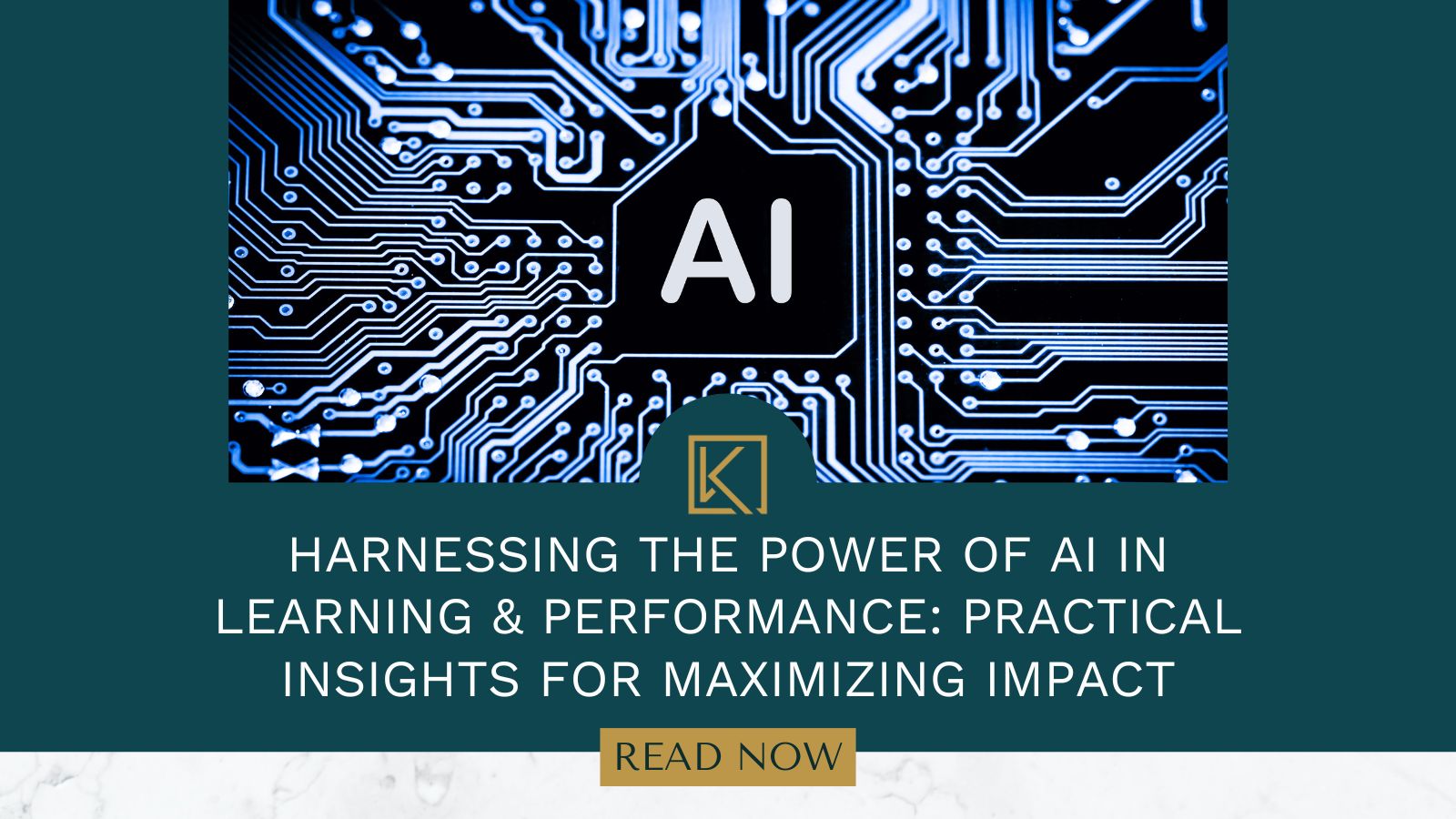Harnessing the Power of AI in Learning & Performance: Practical Insights for Maximizing Impact

Artificial intelligence (AI) is making waves in the workplace, and learning and performance (L&P) professionals are eager to understand how it can drive meaningful change. The challenge lies in understanding how AI can enhance training and evaluation while ensuring it aligns with human-centric goals. The Kirkpatrick Model—a framework for evaluating training impact across four levels: Reaction, Learning, Behavior, and Results—can help make AI integration in L&P meaningful, targeted, and outcome-driven.
Here’s how AI can support each level of the Kirkpatrick Model, offering L&P professionals practical tools and insights to elevate training effectiveness and align it with organizational goals.
AI’s Role in Enhancing Training and Development
AI has the potential to revolutionize L&P by streamlining data collection, automating repetitive tasks, and allowing professionals to focus on high-impact work. However, AI is most powerful when combined with a structured evaluation approach like the Kirkpatrick Model, which ensures that AI applications truly benefit training programs and improve performance outcomes.
The Kirkpatrick Model and AI Integration: A Step-by-Step Approach
1. Level 1 – Reaction: Understanding Initial Feedback with AI
Capturing participant feedback is crucial in any training program. AI can simplify this process by automating surveys or chatbots to gather real-time feedback. Whether through pop-up surveys or sentiment analysis, AI can help trainers quickly assess whether participants find the training engaging, relevant, and beneficial. By automating data collection, L&P teams can obtain immediate insights to refine future sessions.
2. Level 2 – Learning: Measuring Knowledge and Skill Acquisition
At this level, AI assists in analyzing whether participants are genuinely acquiring the intended skills and knowledge. AI tools can be used to assess responses to quizzes, simulate exercises, and even provide real-time feedback. Machine learning algorithms can identify patterns in responses to highlight common challenges, ensuring trainers understand areas where learners may need additional support.
3. Level 3 – Behavior: Evaluating Real-World Application of Skills
For training to have a lasting impact, it must influence on-the-job behavior. AI’s ability to track behavior over time is invaluable here. By integrating AI into workplace systems, organizations can monitor behavioral changes and correlate them with specific training modules. For instance, AI can track employee performance metrics or customer feedback, enabling L&P professionals to see if employees are effectively applying their new skills.
Behavioral evaluation with AI also allows for continuous monitoring, revealing whether participants adopt new skills consistently. Over time, this data provides a holistic view of how training is affecting day-to-day work behaviors, an essential factor in driving sustained performance improvement.
4. Level 4 – Results: Linking Training to Business Outcomes
At the highest level, training evaluation should connect with organizational outcomes. AI can help analyze large data sets to determine the broader impact of training on metrics like productivity, engagement, or profitability. Using predictive analytics, AI tools can even identify leading indicators of success, providing L&P teams with actionable insights that guide future training investments.
AI can also support ROI analysis by automating data collection and reporting, providing decision-makers with a clear view of how training contributes to strategic goals. This insight allows organizations to make informed adjustments to their L&P initiatives and maximize their return on investment.
Key Considerations for AI in L&P
While AI can support each level of the Kirkpatrick Model, the technology is best used as a tool to complement, not replace, human expertise. Here are some best practices for integrating AI in L&P effectively:
- Start Small: Begin by automating simple, repetitive tasks such as survey distribution and data aggregation.
- Ensure Data Accuracy: AI operates on the data it receives; ensure your data inputs are accurate and relevant to avoid misleading outputs.
- Emphasize Human Oversight: AI-driven insights are valuable, but human interpretation and contextual understanding are crucial to make informed decisions.
- Explore Different Tools: AI applications are diverse, with various tools specializing in different tasks (e.g., ChatGPT for content creation or Perplexity AI for literature reviews). Find the tools that best fit your goals.
Preparing for the Future of AI in L&P
As AI technologies continue to evolve, their potential for transforming L&P will only grow. For L&P professionals, building foundational AI knowledge now is critical to stay ahead in a rapidly changing landscape. Organizations that embrace AI thoughtfully—prioritizing both efficiency and ethical considerations—will be well-positioned to lead the way in delivering impactful training.
Conclusion: Elevating L&P with AI and the Kirkpatrick Model
AI offers exciting opportunities for L&P professionals, from automating initial feedback to analyzing training outcomes. By leveraging the Kirkpatrick Model alongside AI, organizations can ensure that technology enhances—not replaces—the human-centric aspects of training and performance. Embracing this balanced approach will help L&P teams drive meaningful change, maximize training ROI, and position their organizations for long-term success.
Ready to dig deeper? Listen to the Kirkpatrick Podcast episode on harnessing AI in L&P to learn practical tips for maximizing impact and aligning training with your organization’s objectives.
Listen to the latest episode here:
LEARN WITH US
If you are on the search for a community that understands you and can provide you with the support you’ve been looking for, we would love to have you as a part of our Kirkpatrick Community! Learn more and join here.
Interested in mastering the Kirkpatrick Model? Dive into the Kirkpatrick Model Toolkit, your comprehensive resource for streamlined and impactful evaluation. Learn more and join here.





